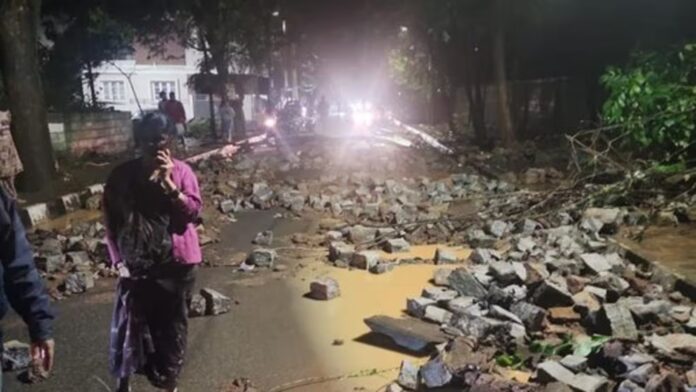Heavy Rains Cause GKVK Wall Collapse in Bengaluru, Highlighting City’s Ongoing Infrastructure Challenges
Bengaluru, known for its vibrant greenery and sprawling urban landscape, faced another infrastructural setback due to heavy rains recently. The compound wall of the Gandhi Krishi Vigyana Kendra (GKVK), located adjacent to the Judicial Layout, collapsed as a result of relentless downpours. This incident once again highlights the city’s ongoing struggle to cope with severe weather, particularly the challenges posed by heavy rainfall on its infrastructure.
The GKVK campus, which covers over 1,200 acres, holds the distinction of being the largest green space in Bengaluru. It surpasses even the combined areas of the well-known Cubbon Park and Lal Bagh, making it a significant ecological and recreational space for the city. The collapse of the wall has raised concerns about the impact of extreme weather on the city’s essential infrastructure, as well as the potential safety hazards such events pose to nearby residents.
Fortunately, the local authorities were quick to respond. The Yelahanka zonal team promptly arrived at the scene to clear the area, ensuring that the immediate danger was addressed. Their swift action helped restore normalcy in the vicinity, mitigating further risk to the public. However, the incident serves as a reminder of the vulnerabilities Bengaluru faces during periods of heavy rainfall, which often leads to flooding, water logging, and other infrastructural damage across the city.
In addition to the challenges posed by the GKVK wall collapse, Bengaluru has been experiencing widespread disruptions due to continuous rain over the past few days. Low-lying areas and several major roads have been inundated, leaving many residents and commuters stranded. The city’s drainage systems have struggled to cope with the sheer volume of water, causing significant inconvenience to the public.
Adding to the concerns, a popular weather blogger recently warned of more potential thunderstorms in Bengaluru. According to a post on X (formerly known as Twitter), thunderstorms were expected after 4:30 PM on the day of the post, particularly affecting the eastern, southeastern, and southern regions of the city. These areas had largely missed out on significant rainfall earlier but were now likely to experience showers over the next three days. The blogger also cautioned residents to be prepared, especially given that many areas were already severely waterlogged.
The relentless downpour over the past 48 hours has caused what some have described as “absolute carnage” across Bengaluru. Waterlogging in several low-lying areas has made it difficult for residents to move around, with flooded roads halting traffic and leaving vehicles stranded. Commuters have faced delays, while pedestrians have had to navigate waterlogged streets, often risking their safety.
This pattern of heavy rain and resulting waterlogging has become a recurring issue for Bengaluru, particularly during the monsoon season. The city’s rapid urbanization, coupled with an aging drainage system, has made it increasingly difficult to manage the influx of water during intense rainstorms. Flood-prone areas and poorly maintained roads exacerbate the problem, with some neighborhoods bearing the brunt of the damage.
Despite efforts by the city’s municipal authorities, such as the Bruhat Bengaluru Mahanagara Palike (BBMP), to address these issues, the challenges remain persistent. Immediate responses, like the one by the Yelahanka zonal team, are crucial in preventing further damage, but long-term infrastructural improvements are needed to prevent such incidents from recurring. Upgrading drainage systems, ensuring better road maintenance, and implementing sustainable urban planning measures could help mitigate the impact of heavy rainfall on the city.
As Bengaluru braces for more rain in the coming days, residents are urged to stay informed about weather updates and take necessary precautions to avoid potential hazards. For now, the city’s resilience will be tested once again, as authorities and citizens work together to navigate the challenges posed by heavy rains and their aftermath.
The GKVK wall collapse serves as a stark reminder of the ongoing struggle to balance urban development with environmental resilience, particularly in a city like Bengaluru, which is both rapidly growing and frequently exposed to the forces of nature.

